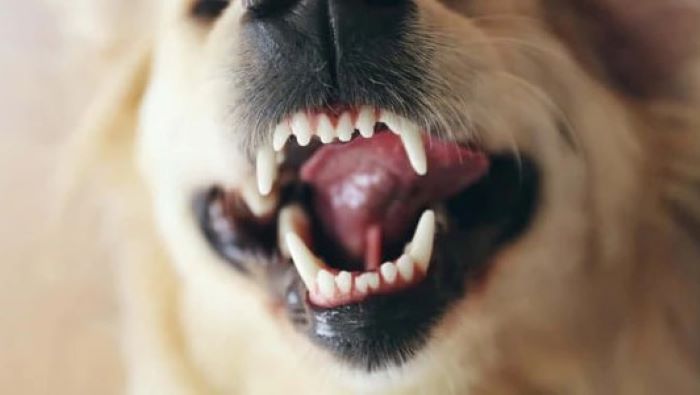How many teeth does your canine friend have? You may already know as a dog owner how important your dog’s dental health is to their general wellbeing. But still, are you aware of the number of teeth dogs have and how they differ from ours?

In this blog post, we’ll explore these questions and more. You’ll learn about the different kinds of teeth dogs have, how their baby teeth fall out and their adult teeth erupt, and how to keep their teeth clean and healthy.
By the time you finish reading this post, Your understanding of your dog’s teeth structure and how to provide the appropriate dental care for them will be enhanced. Want to know more? Let’s start now!
Contents
How Many Teeth Should Dogs Have?
Dogs have two sets of teeth in their lifetime:
1. Baby teeth:
Baby teeth, also known as deciduous or milk teeth, are the first set of teeth that puppies develop. They start to appear when puppies are around two weeks old and are usually fully grown by eight to ten weeks old.
Puppies have 28 baby teeth in total: 12 incisors, 4 canines, and 12 premolars.
2. Adult teeth:
Adult teeth, also known as permanent or secondary teeth, are the second and final set of teeth that dogs develop. They start to erupt when puppies are around four months old and replace the baby teeth.
The process of losing baby teeth and growing adult teeth is called teething and can last until dogs are seven or eight months old.
Adult dogs have 42 teeth in total: 12 incisors, 4 canines, 16 premolars, and 10 molars.

The different types of teeth have different functions and shapes:
- Incisors: Incisors are the small teeth in the front of the mouth that are used for tearing meat from bones and grooming.
- Canines: Canines are the long, pointed teeth on the sides of the mouth that are used for puncturing and holding prey.
- Premolars: Premolars are the sharp teeth behind the canines that are used for shearing and slicing food.
- Molars: Molars are the large, flat teeth at the back of the mouth that are used for grinding and chewing food.
How Do Dogs Lose Their Baby Teeth?
When adult teeth erupt through the gums and the baby tooth’s roots fall out, dogs lose their baby teeth. In the end, this causes the baby teeth to become loose and fall out. The canines, premolars, and incisors typically erupt first, in that order.
1. Signs and Symptoms of Teething in Puppies:
The teething process can cause some discomfort and irritation for puppies, which may make them chew on anything they can find to relieve their pain.
Some signs that your puppy is teething are drooling, bleeding gums, bad breath, whining, loss of appetite, and finding baby teeth around the house.[1]
2. Help Your Puppy During Teething:
To help your puppy during this period, you can provide them with appropriate chew toys or dental treats that are soft and gentle on their gums.
You can also massage their gums with your finger or a soft cloth to soothe them. Avoid giving them hard or brittle objects that could damage their teeth or cause choking.
You should also monitor your puppy’s mouth regularly and check for any signs of infection or abnormality.
How to Keep Your Dog’s Teeth Healthy?
Dogs’ dental hygiene[2] is essential since it not only impacts their mouths but also their general health and wellbeing.
Plaque, tartar, gingivitis, periodontal disease, tooth decay, tooth loss, bad breath, discomfort, infection, and even organ damage can result from poor dental hygiene.
- Brush Your Dog’s Teeth at Home: You should clean your dog’s teeth every day using an animal toothbrush and toothpaste to maintain their dental health.
- Offer Dog-Friendly Toys: You should be offering them toys or chews for their teeth that may aid eliminate tartar and plaque.
- Maintain Diet and Nutrition: Moreover, you should keep away from feeding them snacks or food from people that is heavy in sugar or starch since these might aggravate dental issues.

Get Professional Dental Care
You have to take your dog to the vet for routine dental examinations and cleanings in addition to providing at-home treatment.
Your dog’s mouth may be examined by your veterinarian to look for any sickness or injury, and they can also conduct scaling and polishing to get rid of any built-up plaque and tartar.
Your veterinarian may also provide you advice on the best dental tools and procedures based on your dog’s individual requirements.
FAQs
Do all dogs have 42 teeth?
No, not all dogs have 42 teeth. Some dogs may have more or less than 42 teeth due to genetic variations or abnormalities. For example, some small breeds may have fewer molars or smaller jaws that cannot accommodate all 42 teeth. Some dogs may also lose some of their teeth due to trauma or disease.
How many teeth can dogs lose?
Dogs have 28 baby teeth and 42 adult teeth. They can lose teeth due to dental problems or other causes. Dental health is important to prevent tooth loss and other issues.
Can a dog survive without teeth?
Yes, a dog can survive without teeth if they receive proper care and nutrition. Dogs without teeth may need special diets that consist of soft or moist food that is easy to swallow and digest. They may also need supplements or medications to prevent nutritional deficiencies or infections.
How many teeth do old dogs have?
Old dogs may have fewer teeth than young dogs due to natural wear and tear or dental problems that cause tooth loss. Some old dogs may still have all 42 teeth while others may have only a few left.
Conclusion
Your dog’s teeth play a vital role in their well-being and comfort. By understanding how many teeth they have, how they shed their baby teeth, and how to maintain their adult teeth healthy, you can offer them the best dental care possible.
Don’t forget to brush your dog’s teeth every day, provide them with dental chews or toys, avoid human food or treats that can damage their teeth, and take them to your veterinarian for regular exams and cleaning.
By doing so, you can avoid tooth loss and other dental issues and make sure your dog has a dazzling and lovely smile.
Thank you for reading this blog post on how many teeth do dogs have. We hope you found it informative and helpful.
References:
- Teeth, Teething and Chewing in Puppies | VCA Animal Hospitals. (n.d.). Vca. Retrieved June 2, 2023, from https://vcahospitals.com/know-your-pet/teeth-teething-and-chewing-in-puppies- VCA Hospitals
- Dental Hygiene for Dogs | Pet Talk | VMBS News. (2022, March 11). VMBS News. Retrieved June 2, 2023, from https://vetmed.tamu.edu/news/pet-talk/dental-hygiene-for-dogs/- ATM University

Dania is a dog groomer living in California, who loves styling dogs. She often uses dog accessories to keep them distracted while grooming. She is also a dog parent to a Pomeranian, Duke. It’s because of him she is always on a lookout for the best dog foods, toys, other dog accessories, and ways to keep him equipped, healthy and happy.


